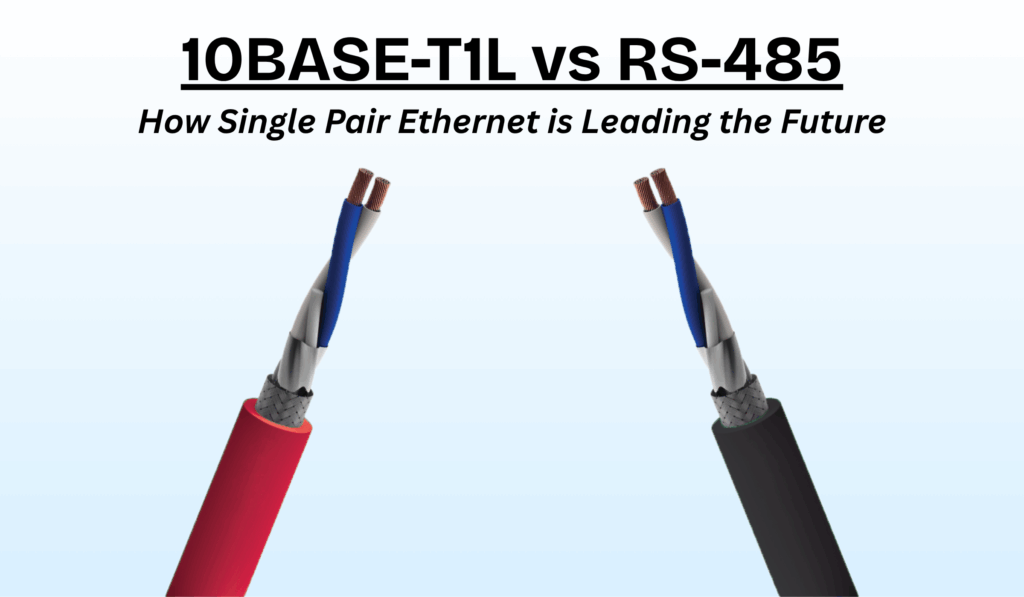At Smart Controls, we’re excited to push a major shift in building automation technology. Our new partnership with ASI Controls marks a commitment to developing integrated solutions that leverage the powerful 10BASE-T1L Ethernet standard, designed to transform how devices in commercial buildings communicate.
In our previous blog post, we introduced the key benefits of 10BASE-T1L. In this article, we will take a closer look at how 10BASE-T1L stacks up against RS-485, the long-standing workhorse of building automation, and why now is the right time to make the leap forward and optimize your building control.

What Is RS-485 and Why Has It Lasted So Long?
RS-485 is a serial communication standard used widely in building automation, supporting protocols like BACnet MS/TP and Modbus RTU. Its strengths include:
- Long-distance communication (up to 4,000 feet at lower data rates)
- Multi-drop bus topology supporting multiple devices per segment
- Noise resistance in industrial environments
However, RS-485 was designed in the 1980s, long before the modern demands of smart buildings, IoT integration, and high-speed data exchange came into play.
Enter 10BASE-T1L: Ethernet Over a Single Pair of Wires
10BASE-T1L is an Ethernet physical layer standard (IEEE 802.3cg) that enables 10 Mbps full-duplex communication over single-pair, twisted copper wires — and over distances up to 1,000 meters.
At first glance, that might sound similar to RS-485, but here’s where 10BASE-T1L surpasses the legacy standard:
Head-to-Head: 10BASE-T1L vs. RS-485
| Feature/Capability | RS-485 | 10BASE-T1L |
| Primary Function | Serial Communication | Single-Pair Ethernet (IP-based) |
| Max Data Rate | Varies based on distance; up to 10 Mbps at 10 m, but drops significantly with distance | 10 Mbps at 1,000 m |
| Max Cable Distance | 1,200 m (at low baud rates) | 1,000 m |
| Wiring | Two wires (differential pair) + ground | Single twisted pair |
| Protocol Support | Serial protocols (BACnet MS/TP, Modbus RTU) | Full Ethernet stack (BACnet/IP, Modbus TCP, BACnet/SC, MQTT, REST, etc.) |
| Network Topology | Multi-drop (bus) | Point-to-point, daisy chain together using switch for bus topology |
| Interoperability | Proprietary or serial-based. Requires gateways to connect to Ethernet | Seamless IP integration, eliminating Ethernet gateways |
| Diagnostics | Limited real-time visibility | Remote diagnostics, real-time monitoring |
6 Reasons to Transition from RS-485 to 10BASE-T1L
- Ethernet from Edge to Cloud
With 10BASE-T1L, field-level devices can now integrate effortlessly into IP networks — eliminating the need for protocol gateways, simplifying integration, and enabling true IoT architectures. - Faster Data, Richer Applications
Consistent and reliable full-duplex 10 Mbps data speed means you can support high-bandwidth applications that include dashboards, diagnostics, analytics, and real-time control. - Improved Diagnostics and Maintenance
Single-Pair Ethernet connectivity enables enhanced access to real-time status, predictive maintenance, and remote diagnostics — capabilities which RS-485 simply cannot offer. - Reduced System Complexity
One physical layer for both IT and OT teams helps reduce network segmentation, simplify training, and streamline installation. - Future-Proofing Using Existing Infrastructure
As more building devices and systems shift toward Ethernet communication, 10BASE-T1L ensures long-term compatibility and scalability for your building by reusing your existing twisted-pair wiring. - No Compromise on Distance
Maintain long cable runs comparable to RS-485 while gaining all the advantages of Ethernet.
Real-World Impact for Building Automation
The transition from RS-485 to 10BASE-T1L represents more than a simple wiring upgrade — it’s a paradigm shift enhancing your control for the future. Commercial buildings are becoming more intelligent, connected, and data-driven. Traditional serial communication limits the potential of modern BAS systems to deliver optimized energy efficiency, occupant comfort, and operational insight.
With a line of integrated solutions co-developed with ASI Controls, Smart Controls is empowering building owners to take full advantage of next-generation Ethernet-based building automation control, built on 10BASE-T1L.
Register for a Smart Controls account or connect with us on LinkedIn (www.linkedin.com/company/smart-controls-llc/) to stay in the know on the latest announcements and news on how we’re helping buildings move toward smarter, more connected operations.
